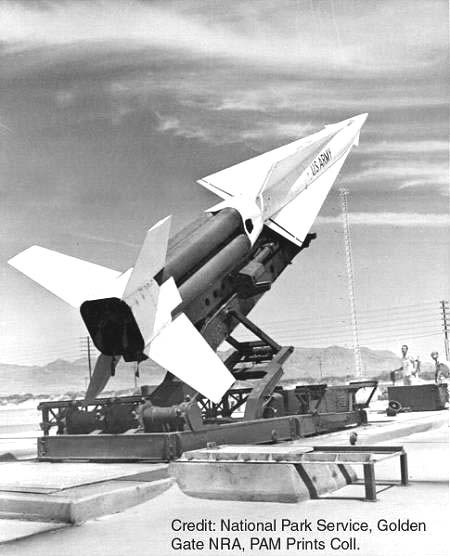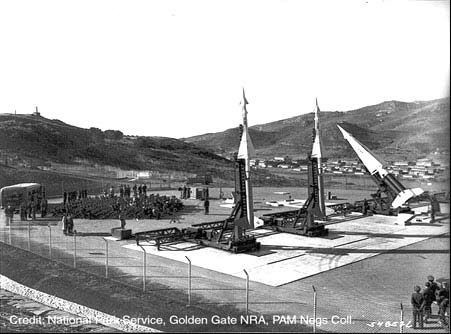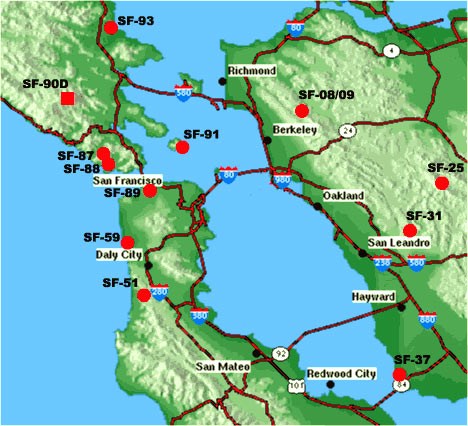Antiaircraft DefensesAfter World War II, the United States entered a “Cold War” with the Union of Soviet Socialist Republics (USSR). During this time, the threat of foreign attack on U.S. soil shifted from naval assault to air attack, particularly by aircraft carrying nuclear weapons. As a response, the Army Air Defense Artillery took responsibility from the Coast Artillery branch for defending the continental United States. In the San Francisco area, antiaircraft defenses were at a continual high state of readiness from the Korean War (1950 -1953) through to the implementation of the Strategic Arms Limitation Treaty of 1972. Coastal defenses around San Francisco during this period largely depended on the Nike antiaircraft missile system. The Nike system was not only the most expensive missile system ever deployed, it was also the most widespread (300 sites in 30 states) and longest-lived (25 years nationwide). The U.S. Army deployed this system to protect urban areas throughout America, bringing the possibility of nuclear attack to suburban backyards and into the national consciousness. 
PARC, Golden Gate National Recreation Area Nike missile systems in the Bay AreaBeginning in 1954, the army constructed 12 permanent launch sites (with their associated control, housing, and command sites) around the Bay Area. In the East Bay, they constructed sites on San Pablo Ridge, Rocky Ridge, Lake Chabot and Coyote Hills; to the north of the Golden Gate, the army constructed sites at Fort Cronkhite, Fort Barry, Angel Island and San Rafael; south of the Golden Gate, sites were constructed at Milagra Ridge, Fort Winfield Scott (the Presidio) and Fort Funston. The army believed this circle of defense protected the area from potential aerial attacks (at least until the development of the intercontinental ballistic missiles). Fort Baker, in Sausalito, Marin County, became the home for the Sixth ARADCOM region (Army Air Defense Command), which commanded the operation of all 12 Bay Area nike missile sites. 
PARC, Golden Gate National Recreation Area 
NPS image An Example of Nike missile administration work: Battery Caulfield at the PresidioThe army constructed their Nike missile site at Fort Winfield Scott, on the Presidio of San Francisco, and identified it as Battery Caulfield. As the army identified all the Nike missile sites by numbers, Battery Caulfield was assigned SF-89L; however it was the only Nike missile battery to be named after an army officer (Lt. Col Thomas D. Caulfield was a Korean War officer who died at the Presidio’s Letterman Army Hospital). Since 1952, the 740th AAA Missile Battalion (740 AAAMBn), as part of the larger 30th Antiaircraft Artillery (AAA) Group, managed Battery Caulfield from Fort Winfield Scott. In 1957, the army constructed Presidio Building 1648, a one-story concrete building that functioned as the battalion headquarters facility administration building for the 740th AAA Missile Battalion. This building housed the army’s S-2 branch (Security Intelligence) and the S-3 branch (Operations.) The soldiers who worked in this building were responsible for establishing and maintaining security clearance levels, by preparing people for security clearance, establishing their personal histories and obtaining their fingerprints. All of the classified material related to the Presidio’s Nike missile program would funnel through this office. The men who actually worked the launch site and the Integrated Fire Control (IFC) lived across the street in Fort Winfield Scott barracks.
For more detailed information about the army used AAA Battalion Headquarters Building Presidio Building 1648, please visit presidio-building-1648-a-cold-war-administration-headquarters.htm
To learn more about visiting the Golden Gate National Recreation Area's Nike missile site (the only fully restore Nike missile site in the country), please visit https://www.nps.gov/goga/nike-missile-site.htm
|
Last updated: August 12, 2019
